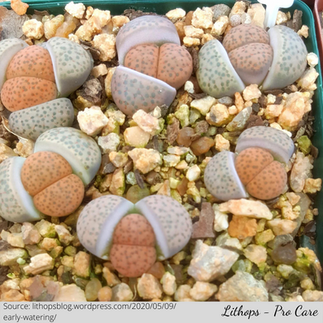Lithops 'Living Stones' Care
- Green Lady Gardens
- Sep 7, 2022
- 3 min read
Updated: Nov 17, 2023
Lithops are native to deserts in southern Africa and are true masters of evolution.
The majority of a Lithops grows underground. It has two leaves with flat tops that grow flush with the surface soil. Lithops do not have a stem. Instead, the two leaves taper into a cone that ends in a single long tap root with fine root hairs.
This minimal above ground exposure protects Lithops from predators, extreme heat, and blazing sun. But minimal exposure of the plant also means there are not a lot of chloroplasts above ground. Chloroplasts, which contain chlorophyll, convert energy from the sun into sugars that plants need to survive via photosynthesis. The challenge for Lithops is that they must do enough photosynthesis to support the entirety of the plant above and below ground despite minimal exposure to the sun. To overcome this problem, a Lithops leaf is partially or completely translucent on the top.This epidermal window allows light to enter the leaf, which is full of a translucent water-storing tissue, to access chloroplasts deep inside the plant.
By housing chloroplasts in its subterranean leaves, Lithops are also able to conserve energy.
When a plant absorbs more energy from the sun than it can use to do photosynthesis, the plant converts that energy to heat. Heat damages critical nutrients and the conversion of excess energy to heat uses up water resources. For Lithops, conservation of water is essential. Lithops have also evolved to have smaller leaves in drier locations to minimize sun exposure.
With that background knowledge, let’s learn how to take care of your evolutionary marvel!
Tolerates
Neglect, heat, drought, being root bound.
Light
Three - five hours of direct morning sun plus more hours of indirect afternoon sun. Burns easily if light & heat are too intense & if not slowly acclimated to brighter light, including grow lights. Lithops grow in deserts but do not burn because they are cooled by breezes (can handle more sun in lower temps.) Sun exposure/photosynthesis is also lower because they grow much deeper in the soil, which partially covers them, & in the shade of small rocks & crevices. Low light = Leaves lose color/pattern & elongate. Can use grow lights but must acclimate to this increased light exposure to prevent burn.
Water
Only 3 - 5 times/year. Morning is best.
Summer: Dormant. Do NOT water unless it shrivels a lot. But water very lightly so only the top ¼ - ½ inch of the soil is damp.
Fall: Water thoroughly when a bloom appears. Let dry 100% before watering thoroughly again. Do this until the bloom dies. Stop watering.
Winter: Do NOT water. New leaves emerge & draw water from old leaves. Old leaves split & dry.
Spring: Pick off old leaves when 100% dry/ crispy. Water lightly. (Top 1/2 inch.) Let dry 100%, until tops of leaves shrivel. Water lightly again. Stop watering in mid - late spring.
Overwatering = White spots on leaves, yellowing, squishy stem, blisters, bursts.
Humidity
Keep as dry as possible.
Temperature
60° - 80°F. Up to 100° but not less than 50°.
Fertilizer
Not necessary as they grow in low nutrient environments. You can but you risk over fertilizing.
Potting & Soil
Must drain very well. (You may need to change the soil it comes in.) Combine cactus soil with 20-50% rocky, sandy, & gritty substrate. The less organic matter, peat, & moisture retention, the better. Pot must have drainage & be deep enough for lithops' long roots. A terra cotta pot is ideal.





























Comments